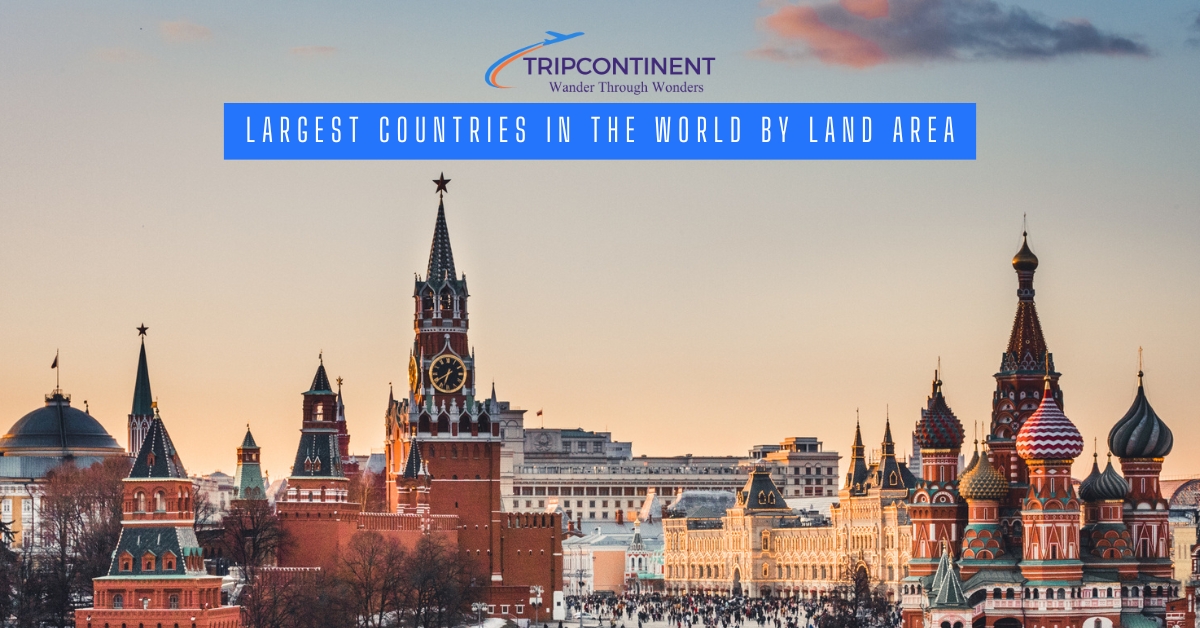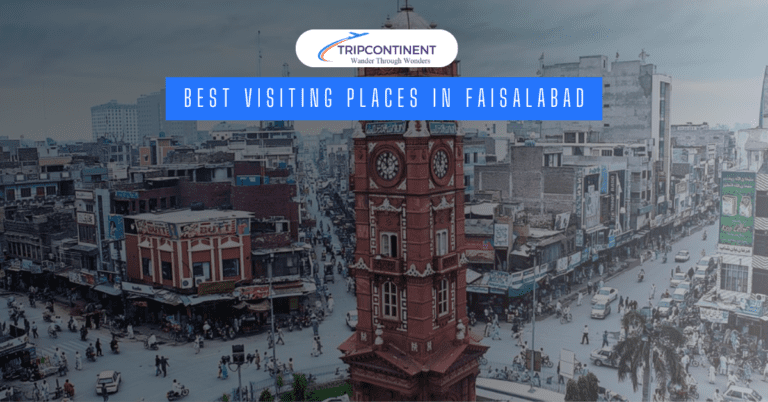Top 10 Largest Countries in the World by Land Area
When it comes to size, some countries stand out far beyond others, boasting vast expanses of land that encompass a variety of landscapes, climates, and cultures. From the frozen tundras of the Arctic to the sun-drenched deserts of the Sahara, the world’s largest countries by area showcase incredible geographic diversity and play significant roles on the global stage.
In this exploration of the Largest Countries in the World by Area, we’ll take a closer look at the top ten nations that dominate the globe regarding landmass. Each country offers a unique blend of natural beauty, cultural richness, and historical significance, making them essential contributors to the world’s economic, political, and environmental landscapes.
List of the Largest Countries in the World by Area (km²)
The following is the list of largest countries in the world by area.
- Russia – 17,098,242 km²
- Canada – 9,984,670 km²
- United States – 9,833,517 km²
- China – 9,596,961 km²
- Brazil – 8,515,767 km²
- Australia – 7,692,024 km²
- India – 3,287,263 km²
- Argentina – 2,780,400 km²
- Kazakhstan – 2,724,900 km²
- Algeria – 2,381,741 km²
1. Russia
When discussing the largest countries in the world by area, Russia undeniably stands at the forefront, claiming the title of the largest country on Earth. Spanning over 17 million square kilometers (approximately 6.6 million square miles), Russia occupies more than one-eighth of the world’s inhabited land area. This vast expanse stretches across two continents—Europe and Asia—making Russia a transcontinental nation with an unparalleled geographic diversity.
Russia’s immense size gives it a remarkable variety of landscapes, climates, and natural resources. From the icy tundras of Siberia to the vast steppes, dense forests, and towering mountain ranges, the country’s geography is as diverse as it is expansive. The Ural Mountains, which run north to south through western Russia, are often considered the boundary between European and Asian Russia. To the south, the Caucasus Mountains form a natural border with the Middle East.
In the west, the European portion of Russia includes the capital, Moscow, and the historic city of St. Petersburg, while the eastern part extends to the Pacific coast, where cities like Vladivostok and the Kamchatka Peninsula offer breathtaking views of volcanic landscapes and rugged coastlines.
Russia’s enormous land area also means it is incredibly rich in natural resources. The country is home to vast reserves of oil, natural gas, coal, minerals, and precious metals, making it one of the world’s leading producers of energy and raw materials.
Beyond its physical size, Russia’s influence on global history, culture, and politics is immense. As the heart of the former Soviet Union, Russia played a central role in 20th-century global affairs and continues to be a major geopolitical player today.
Also see: Most Traded Currencies in the World
2. Canada
Canada, the world’s second-largest country by area, is a land of breathtaking natural beauty, spanning approximately 9.98 million square kilometers (about 3.85 million square miles). This vast nation, known for its pristine wilderness, diverse landscapes, and multicultural cities, stretches from the Atlantic Ocean in the east to the Pacific Ocean in the west, and up to the Arctic Ocean in the north.
Canada’s geography is incredibly diverse, featuring towering mountain ranges, expansive prairies, dense forests, and over two million lakes—the most of any country in the world. The Rocky Mountains, located in the western provinces of British Columbia and Alberta, are among the most famous natural landmarks, attracting millions of tourists each year with their stunning vistas and world-class skiing resorts.
The central part of Canada, known as the Prairies, is characterized by vast, open plains that are the heart of the country’s agricultural industry. To the east, the provinces of Quebec and Ontario boast rolling hills, lush forests, and the iconic Great Lakes, while the northern territories offer a glimpse into the Arctic, with its tundra, ice fields, and unique wildlife.
Canada’s vast land area is also rich in natural resources, including oil, natural gas, minerals, and timber. The country is one of the world’s leading producers of petroleum, particularly from the oil sands of Alberta. Additionally, Canada is a major player in the mining industry, with significant deposits of gold, nickel, uranium, and diamonds.
Canada is also recognized for its cultural diversity. It is a country built by immigrants, with people from all over the world calling it home. This multiculturalism is celebrated in cities like Toronto, Vancouver, and Montreal, where diverse communities live side by side, contributing to the rich culture of the nation.
3. United States
The United States of America, commonly referred to as the U.S. or USA, is the fourth-largest country in the world by area, covering approximately 9.8 million square kilometers (about 3.8 million square miles). This vast nation is known for its diverse landscapes, dynamic culture, and significant global influence, making it one of the most prominent countries on the world stage.
The geography of the United States is as varied as its people, encompassing everything from towering mountain ranges and expansive deserts to fertile plains, dense forests, and extensive coastlines. In the west, the Rocky Mountains and Sierra Nevada offer stunning natural beauty, while the Grand Canyon in Arizona showcases the dramatic power of natural erosion. The Great Plains, stretching across the central part of the country, are known for their agricultural productivity, contributing significantly to the nation’s food supply.
To the east, the Appalachian Mountains provide a backdrop to the historic and densely populated regions along the Atlantic coast. The southern part of the country is home to the subtropical wetlands of the Everglades in Florida, while the northern states along the Great Lakes enjoy a temperate climate with rich forests and freshwater resources. The United States also has vast coastal areas, including the Pacific coastline in the west and the Atlantic coastline in the east, both of which are vital to trade, tourism, and ecological diversity.
The United States is often considered a cultural superpower, with its influence reaching far beyond its borders through music, film, literature, and technology. American pop culture, including Hollywood movies, and music genres like jazz, rock, hip-hop, and fast food, has become a global phenomenon, shaping trends and lifestyles around the world.
As a leading global power, the United States plays a central role in international politics and diplomacy. It is a founding member of the United Nations and NATO and maintains a network of alliances and military bases around the world. The U.S. military is one of the most advanced and powerful, capable of projecting power globally and responding to international crises.
You might also like: Largest Waterfalls in the United States
4. China
China, the world’s third-largest country by area, is a vast and diverse nation that covers approximately 9.6 million square kilometers (about 3.7 million square miles). With its extensive landscapes, rich history, and rapid modernization, China is a country of contrasts, where ancient traditions coexist with cutting-edge technology.
China’s geography is incredibly diverse, ranging from towering mountain ranges to expansive deserts, fertile plains, and long coastlines. In the west, the Himalayas and the Tibetan Plateau dominate the landscape, with Mount Everest, the world’s highest peak, straddling the border between China and Nepal. The northwest is home to the arid Gobi and Taklamakan Deserts, while the fertile plains of the east support China’s dense population and agricultural activities.
The country’s major rivers, including the Yangtze and the Yellow River, have played a crucial role in its development, providing water for agriculture, transportation, and energy. The Yangtze River, the longest in Asia, flows through several major cities and is a lifeline for millions of people.
China’s history spans thousands of years, making it one of the world’s oldest continuous civilizations. The country has been the birthplace of major philosophical traditions, including Confucianism, Taoism, and Buddhism, which have deeply influenced Chinese culture and society. Ancient China was also home to remarkable innovations, such as paper, gunpowder, the compass, and printing, which have had a lasting impact on the world.
In recent decades, China has transformed itself into one of the world’s leading economic powers. Since the late 20th century, the country has undergone rapid industrialization and urbanization, emerging as a global manufacturing hub and the world’s second-largest economy by nominal GDP. Major cities like Beijing, Shanghai, and Shenzhen have become centers of finance, technology, and innovation, driving China’s economic growth.
As a permanent member of the United Nations Security Council and a nuclear power, China is a key player in global politics. The country’s growing military and economic might have made it a central figure in international relations, with its policies and actions having far-reaching implications for the world.
5. Brazil
Brazil, the largest country in South America and the fifth-largest in the world covers approximately 8.5 million square kilometers (about 3.3 million square miles). Known for its stunning natural beauty, vibrant culture, and rich biodiversity, Brazil is a country of immense contrasts, where modern cities, lush rainforests, and sprawling coastlines coexist.
Brazil’s geography is incredibly diverse, featuring some of the most iconic landscapes on the planet. The Amazon Rainforest, often called the “lungs of the Earth,” is the largest tropical rainforest in the world and covers a significant portion of northern Brazil. This vast and dense forest is home to an incredible array of wildlife, including many species that are found nowhere else on Earth.
The Amazon River, the second-longest river in the world, winds its way through the rainforest, supporting countless ecosystems and communities. To the south, the Pantanal, the world’s largest tropical wetland, is a haven for wildlife, particularly during the rainy season when the plains flood and attract a wide variety of birds, reptiles, and mammals.
Brazil is also known for its extensive Atlantic coastline, which stretches for over 7,400 kilometers (4,600 miles). This coastline is dotted with beautiful beaches, vibrant cities like Rio de Janeiro and Salvador, and unique ecosystems such as the Atlantic Forest, which is rich in biodiversity but highly endangered.
Brazil is one of the world’s leading producers of natural resources, particularly in agriculture and mining. The country is a major exporter of soybeans, coffee, sugarcane, and beef, and its vast arable land has made it a global agricultural powerhouse.
Brazil is the largest economy in South America and plays a significant role in global trade and diplomacy. As a member of BRICS (an association of emerging economies that includes Brazil, Russia, India, China, and South Africa), Brazil has become increasingly influential on the world stage.
6. Australia
Australia, the sixth-largest country in the world by area, is a land of remarkable contrasts and unique natural wonders. Covering approximately 7.7 million square kilometers (about 2.9 million square miles), Australia is both a country and a continent, distinguished by its vast deserts, lush rainforests, stunning coastlines, and vibrant cities. Its geographic isolation has resulted in a distinctive biodiversity found nowhere else on Earth.
Australia’s landscape is incredibly diverse, ranging from the arid Outback to the tropical rainforests of Queensland, and from the snowy peaks of the Australian Alps to the pristine beaches of the Great Barrier Reef. The Outback, a term often used to describe the remote and arid interior of the country, is characterized by its red deserts, rugged mountain ranges, and sparse vegetation. This vast region is home to iconic landmarks such as Uluru (Ayers Rock) and the Simpson Desert, both of which hold deep cultural significance for Indigenous Australians.
The eastern coast of Australia features fertile plains and rolling hills, with major cities like Sydney, Brisbane, and Melbourne located in this more temperate and populous region. The Great Dividing Range, a mountain range running parallel to the east coast, plays a crucial role in shaping the climate and ecosystems of the region.
The northern part of Australia, particularly in Queensland and the Northern Territory, is characterized by tropical rainforests, wetlands, and savannas. The Great Barrier Reef, the largest coral reef system in the world, stretches along the Queensland coast and is one of the most famous natural attractions on the planet, known for its stunning marine biodiversity.
Australia is rich in natural resources, which have played a key role in its economic development. The country is one of the world’s leading producers of minerals, including iron ore, coal, gold, and bauxite. Western Australia, in particular, is known for its vast mineral wealth, with large-scale mining operations driving much of the region’s economy.
Culturally, Australia has made significant contributions to the arts, sports, and science. Australian cinema, music, and literature have gained international recognition, and the country is known for its strong sporting culture, particularly in cricket, rugby, and Australian rules football.
7. India
India, the seventh-largest country in the world by area, spans approximately 3.29 million square kilometers (about 1.27 million square miles). Known for its rich cultural heritage, diverse landscapes, and significant global influence, India is a country of contrasts and complexities, where ancient traditions coexist with rapid modernization.
India’s geography is incredibly varied, featuring some of the world’s most dramatic landscapes. The northern part of the country is dominated by the towering Himalayas, the highest mountain range in the world, which includes Mount Everest and Kanchenjunga, the third-highest peak on Earth. These snow-capped mountains not only provide stunning scenery but also serve as the source of major rivers like the Ganges, Yamuna, and Brahmaputra, which are vital to the country’s agriculture and cultural practices.
The fertile Indo-Gangetic Plain stretches across northern and eastern India, serving as the breadbasket of the country. This region, watered by the Ganges and its tributaries, supports a dense population and is a center of agricultural production, particularly for crops like rice, wheat, and sugarcane.
In contrast, the Thar Desert, located in the western state of Rajasthan, is a vast arid region characterized by dunes, sparse vegetation, and extreme temperatures. The western coast of India, bordered by the Arabian Sea, features the Western Ghats, a mountain range known for its rich biodiversity and lush forests. To the east, the Eastern Ghats run parallel to the Bay of Bengal, though they are less continuous and rugged than their western counterpart.
The southern part of India, known as the Deccan Plateau, is a large, elevated region surrounded by the Western and Eastern Ghats. This plateau is interspersed with rivers, hills, and forests, and it supports a mix of agriculture and industry. The coastal regions of India, with their beautiful beaches and port cities, play a crucial role in the country’s economy and tourism.
India is one of the world’s oldest continuous civilizations, with a history that stretches back over 5,000 years. It is the birthplace of major religions such as Hinduism, Buddhism, Jainism, and Sikhism, which have shaped the cultural and spiritual life of millions of people.
India is a significant player on the global stage, with a growing influence in international politics, trade, and culture. As a founding member of the United Nations and a member of the BRICS group, India plays a crucial role in shaping global policies and addressing international challenges.
Also explore: Seven Wonders of the World
8. Argentina
Argentina, the eighth-largest country in the world by area, spans approximately 2.78 million square kilometers (about 1.07 million square miles). Located in the southern part of South America, Argentina is known for its stunning natural landscapes, rich cultural heritage, and diverse ecosystems that range from the Andean mountains to the vast Pampas plains and the dramatic southern regions of Patagonia.
Argentina is a country of remarkable geographic diversity, with landscapes that vary dramatically from north to south. The Andes, the longest continental mountain range in the world, form the western border with Chile, offering breathtaking vistas and some of the highest peaks in the Americas, including Aconcagua, which at 6,959 meters (22,831 feet) is the tallest mountain in the Southern and Western Hemispheres.
To the east of the Andes lies the fertile Pampas, a vast expanse of flat grasslands that covers much of central Argentina. This region is also home to Buenos Aires, the vibrant capital city, known for its European-style architecture, bustling cultural scene, and passionate tango music and dance.
The northern regions of Argentina, including the provinces of Salta, Jujuy, and Tucumán, are characterized by a subtropical climate and diverse landscapes that include the lush Yungas forests and the arid deserts of the Puna. The Iguazu Falls, located on the border with Brazil, is one of the most spectacular natural wonders in the world, drawing visitors with their awe-inspiring beauty. In the south, Patagonia offers a stark contrast with its rugged terrain, glacial lakes, and vast steppes.
The country is one of the world’s leading producers of agricultural products, particularly beef, soybeans, and wine. The fertile Pampas region is the backbone of Argentina’s agricultural industry, while the wine-growing regions of Mendoza and San Juan are internationally renowned for their Malbec and other varieties.
Argentina is one of the largest and most influential countries in South America, playing a key role in regional politics, trade, and diplomacy. It is a founding member of the United Nations and the Organization of American States (OAS), and it participates actively in regional organizations such as the Southern Common Market (Mercosur) and the Union of South American Nations (UNASUR).
9. Kazakhstan
Kazakhstan, the ninth-largest country in the world by area, spans approximately 2.72 million square kilometers (about 1.05 million square miles). Located in Central Asia, Kazakhstan is a land of vast steppes, soaring mountains, expensive desserts, and a rich cultural history that blends nomadic traditions with modern influences. Despite being landlocked, Kazakhstan’s diverse landscapes and strategic location have made it a key player in the region.
Kazakhstan’s geography is dominated by the vast Kazakh Steppe, one of the largest dry grasslands in the world. This expansive plain, covering much of the northern and central parts of the country, is characterized by its flat terrain, sparse vegetation, and wide-open spaces. The steppe has historically been the heartland of Kazakh nomadic culture, where herders once roamed with their livestock, living in traditional yurts.
To the south and southeast, Kazakhstan’s landscape becomes more varied, with the Tien Shan and Altai mountain ranges forming natural borders with neighboring countries like Kyrgyzstan and China.
In the western part of the country lies the Caspian Depression, a low-lying area that dips below sea level, leading to the shores of the Caspian Sea—the world’s largest inland body of water. The Caspian Sea is vital to Kazakhstan’s economy, as it is rich in oil and natural gas reserves.
The southern region of Kazakhstan is home to deserts like the Kyzylkum and parts of the vast Aral Sea Basin. The Aral Sea, once one of the largest lakes in the world, has been shrinking dramatically due to the diversion of rivers for irrigation, leading to one of the most significant environmental disasters of the 20th century.
Kazakhstan’s strategic location and abundant resources have made it a key player in Central Asia. The country is a member of several regional and international organizations, including the United Nations, the Shanghai Cooperation Organization (SCO), and the Eurasian Economic Union (EAEU). Kazakhstan has also played an active role in global diplomacy, hosting important international talks and promoting nuclear non-proliferation.
10. Algeria
Algeria, the largest country in Africa and the tenth-largest in the world covers an impressive area of approximately 2.38 million square kilometers (about 919,595 square miles). Situated in North Africa, Algeria is known for its vast desert landscapes, rich history, and cultural diversity. From the Mediterranean coastline to the depths of the Sahara Desert, Algeria’s geography and history make it a unique and fascinating nation.
The northern region of Algeria, known as the Tell Atlas, is characterized by fertile plains and rolling hills, where the majority of the population resides. The Tell Atlas is home to Algeria’s major cities, including the capital, Algiers, and the historic cities of Oran and Constantine. Algiers, often called “Algiers the White” due to its whitewashed buildings, is a vibrant city with a mix of Ottoman, French colonial, and modern architecture.
Beyond the coastal plains, the Atlas Mountains stretch across the northern part of the country, providing a natural barrier between the Mediterranean coast and the vast Sahara Desert.
The Sahara Desert dominates southern Algeria, offering some of the most iconic desert landscapes in the world. This region is known for its endless dunes, rocky plateaus, and ancient caravan routes. The Tassili n’Ajjer, a UNESCO World Heritage Site, is a vast plateau in the southeastern part of the Sahara, famous for its prehistoric rock art and unique geological formations.
Algeria is endowed with significant natural resources, particularly oil and natural gas, which are the backbone of the country’s economy. The country has the largest proven natural gas reserves in Africa and is one of the top gas exporters in the world. The Hassi R’Mel gas field, located in the central part of the country, is one of the largest natural gas fields globally and plays a crucial role in Algeria’s energy sector.
Algeria is a significant player in North Africa and the wider Arab world. It is a member of the African Union, the Arab League, and the Organization of the Petroleum Exporting Countries (OPEC). Algeria’s strategic location and abundant natural resources give it a critical role in regional and global energy markets.
Here’s a table with the top 10 largest countries in the world by area:
| Rank | Country | Area (km²) | Area (mi²) |
| 1 | Russia | 17,098,242 | 6,601,668 |
| 2 | Canada | 9,984,670 | 3,855,100 |
| 3 | United States | 9,833,517 | 3,796,742 |
| 4 | China | 9,596,961 | 3,705,407 |
| 5 | Brazil | 8,515,767 | 3,287,956 |
| 6 | Australia | 7,692,024 | 2,969,907 |
| 7 | India | 3,287,263 | 1,269,219 |
| 8 | Argentina | 2,780,400 | 1,073,518 |
| 9 | Kazakhstan | 2,724,900 | 1,052,089 |
| 10 | Algeria | 2,381,741 | 919,595 |
Conclusion
As we reflect on the Largest Countries in the World by Area, it becomes clear that their influence extends far beyond their borders. They are integral players on the world stage, their actions and policies resonating globally. Understanding the scale and significance of these countries helps us appreciate the rich complexity of our world and the crucial role these giants play in shaping our collective future.
FAQs
What Are the Top 3 Most Powerful Countries?
The top three most powerful countries, considering factors like military strength, economic influence, and geopolitical impact, are generally recognized as:
- United States
- China
- Russia
Which Country Is the Richest?
Luxembourg often ranks as the richest country in terms of GDP per capita, which measures economic output per person. This small European nation benefits from a high-income economy, financial services sector, and strong international trade.
What Are the Top 3 Most Populous Countries in the World?
The top three most populous countries in the world are:
- China
- India
- United States
What Are the 10 Countries With the Largest Population?
As of the latest available data, the ten countries with the largest populations are:
- China
- India
- United States
- Indonesia
- Pakistan
- Nigeria
- Brazil
- Bangladesh
- Russia
- Mexico
What Are the 10 Largest Economies in the World?
As of the latest data, the ten largest economies in the world by nominal Gross Domestic Product (GDP) are:
- United States
- China
- Japan
- Germany
- India
- United Kingdom
- France
- Canada
- Russia
- Brazil

I’m Sophia Jones, an adventurer at heart from New York City, USA. I live for travel and exploration, always eager to discover new places, meet fascinating people, and try out diverse cuisines. Over the past few years, I’ve traveled to numerous countries, immersing myself in different cultures and creating unforgettable memories.






